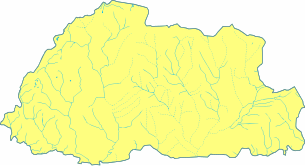Kurmaed Province
Kurmaed Province(Dzongkha:ཀུར་སྨད་;Wylie:kur-smad;"LowerKur") was one of the nine historicalProvinces of Bhutan.[1]
Kurmaed Province occupied lands in southeasternBhutan.It was administered jointly withKurtoed Province.By the 19th century, the ruling governor had become subordinate to thePenlop of Trongsa,who wielded effective power throughout eastern Bhutan.[1][2]
History[edit]
Under Bhutan's early theocraticdual system of government,decreasingly effective central government control resulted in thede factodisintegration of the office ofZhabdrungafter the death of ZhabdrungNgawang Namgyalin 1651. Under this system, the Zhabdrung reigned over the temporalDruk Desiand religiousJe Khenpo.Two successor Zhabdrungs – the son (1651) and stepbrother (1680) of Ngawang Namgyal – were effectively controlled by the Druk Desi and Je Khenpo until power was further splintered through the innovation of multiple Zhabdrung incarnations, reflecting speech, mind, and body. Increasingly secular regional lords (penlopsand dzongpons) competed for power amid a backdrop of civil war over the Zhabdrung and invasions fromTibet,and theMongol Empire.[3]The penlops ofTrongsaandParo,and the dzongpons ofPunakha,Thimphu,andWangdue Phodrangwere particularly notable figures in the competition for regional dominance.[3][4]During this period, there were a total of nine provinces and eightpenlopsvying for power.[5]
Traditionally, Bhutan comprised nine provinces:Trongsa,Paro,Punakha,Wangdue Phodrang,Daga(also Taka, Tarka, or Taga),Bumthang,Thimphu,Kurtoed(also Kurtoi, Kuru-tod), and Kurmaed (or Kurme, Kuru-mad). The Provinces of Kurtoed and Kurmaed were combined into one local administration, leaving the traditional number of governors at eight. While some lords werePenlops,others held the titleDzongpen(Dzongkha:རྗོང་དཔོན་;Wylie:rjong-dpon;also "Jongpen," "Dzongpön" ); both titles may be translated as "governor."[1]
ChogyalMinjur Tenpa (1613–1680;r.1667–1680) was the firstPenlop of Trongsa(Tongsab), appointed byZhabdrung Ngawang Namgyal.He was born Damchho Lhundrub in Min-Chhud,Tibet,and led a monastic life from childhood. Before his appointment as Tongsab, he held the appointed post of Umzey (Chant Master). A trusted follower of the Zhabdrung, Minjur Tenpa was sent to subdue kings of Bumthang, Lhuntse, Trashigang, Zhemgang, and other lords fromTrongsa Dzong.After doing so, the Tongsab divided his control in the east among eight regions (Shachho Khorlo Tsegay), overseen by Dungpas and Kutshabs (civil servants). He went on to buildJakar,Lhuentse,Trashigang, and Zhemgang Dzongs.[6]: 106
The 10thPenlop of TrongsaJigme Namgyel(r.1853–1870) began consolidating power, paving the way for his son the 12th Penlop of Trongsa (and 21st Penlop of Paro)Ugyen Wangchuckto prevail in battle against all rivalpenlopsand establishthe monarchyin 1907. With the establishment of the monarchy and consolidation of power, the traditional roles of provinces, their rulers, and thedual system of governmentcame to an end.[7][8]
See also[edit]
References[edit]
- ^abcMadan, P. L. (2004).Tibet, Saga of Indian Explorers (1864–1894).Manohar Publishers & Distributors. pp. 77et seq.ISBN81-7304-567-4.Retrieved2011-08-14.
- ^
 This article incorporates text from this source, which is in thepublic domain:White, J. Claude (1909).Sikhim & Bhutan: Twenty-One Years on the North-East Frontier, 1887–1908.New York: Longmans, Green & Co. pp. 11, 272–3, 301–10.Retrieved2010-12-25.
This article incorporates text from this source, which is in thepublic domain:White, J. Claude (1909).Sikhim & Bhutan: Twenty-One Years on the North-East Frontier, 1887–1908.New York: Longmans, Green & Co. pp. 11, 272–3, 301–10.Retrieved2010-12-25.
- ^ab
 This article incorporates text from this source, which is in thepublic domain.Worden, Robert L. (September 1991). Savada, Andrea Matles (ed.).Bhutan: A Country Study.Federal Research Division.Administrative Integration and Conflict with Tibet, 1651–1728.
This article incorporates text from this source, which is in thepublic domain.Worden, Robert L. (September 1991). Savada, Andrea Matles (ed.).Bhutan: A Country Study.Federal Research Division.Administrative Integration and Conflict with Tibet, 1651–1728.
- ^
 This article incorporates text from this source, which is in thepublic domain.Worden, Robert L. (September 1991). Savada, Andrea Matles (ed.).Bhutan: A Country Study.Federal Research Division.Civil Conflict, 1728–72.
This article incorporates text from this source, which is in thepublic domain.Worden, Robert L. (September 1991). Savada, Andrea Matles (ed.).Bhutan: A Country Study.Federal Research Division.Civil Conflict, 1728–72.
- ^Zetland (Marquis of), Lawrence John Lumley Dundas; Ronaldsha, E.; Asian Educational Services (2000).Lands of the Thunderbolt: Sikhim, Chumbi & Bhutan.Asian Educational Services. p. 204.ISBN81-206-1504-2.Retrieved2011-08-10.
- ^Dorji, C. T. (1994). "Appendix III".History of Bhutan based on Buddhism.Sangay Xam, Prominent Publishers. p. 200.ISBN81-86239-01-4.Retrieved2011-08-12.
- ^Padma-gliṅ-pa (Gter-ston); Harding, Sarah (2003). Harding, Sarah (ed.).The life and revelations of Pema Lingpa.Snow Lion Publications. p. 24.ISBN1-55939-194-4.Retrieved2011-08-10.
- ^Brown, Lindsay; Mayhew, Bradley; Armington, Stan; Whitecross, Richard W. (2007).Bhutan.Lonely Planet Country Guides (3 ed.).Lonely Planet.pp. 38–43.ISBN978-1-74059-529-2.Retrieved2011-08-09.

